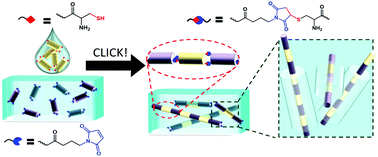Polyelectrolyte character of rigid rod peptide bundlemer chains constructed via hierarchical self-assembly†
Abstract
Short α-helical peptides were computationally designed to self-assemble into robust coiled coils that are antiparallel, homotetrameric bundles. These peptide bundle units, or ‘bundlemers’, have been utilized as anisotropic building blocks to construct bundlemer-based polymers via a hierarchical, hybrid physical-covalent assembly pathway. The bundlemer chains were constructed using short linker connections via ‘click’ chemistry reactions between the N-termini of bundlemer constituent peptides. The resulting bundlemer chains appear as extremely rigid, cylindrical rods in transmission electron microscopy (TEM) images. Small angle neutron scattering (SANS) shows that these bundlemer chains exist as individual rods in solution with a cross-section that is equal to that of a single coiled coil bundlemer building block of ≈20 Å. SANS further confirms that the interparticle solution structure of the rigid rod bundlemer chains is heterogeneous and responsive to solution conditions, such as ionic-strength and pH. Due to their peptidic constitution, the bundlemer assemblies behave like polyelectrolytes that carry an average charge density of approximately 3 charges per bundlemer as determined from SANS structure factor data fitting, which describes the repulsion between charged rods in solution. This repulsion manifests as a correlation hole in the scattering profile that is suppressed by dilution or addition of salt. Presence of rod cluster aggregates with a mass fractal dimension of ≈2.5 is also confirmed across all samples. The formation of such dense, fractal-like cluster aggregates in a solution of net repulsive rods is a unique example of the subtle balance between short-range attraction and long-rage repulsion interactions in proteins and other biomaterials. With computational control of constituent peptide sequences, it is further possible to deconvolute the underlying sequence driven structure–property relationships in the modular bundlemer chains.



 Please wait while we load your content...
Please wait while we load your content...
